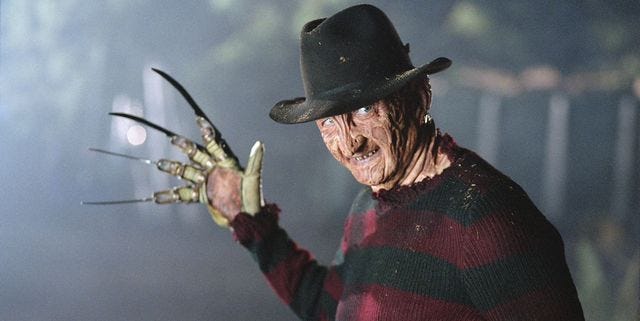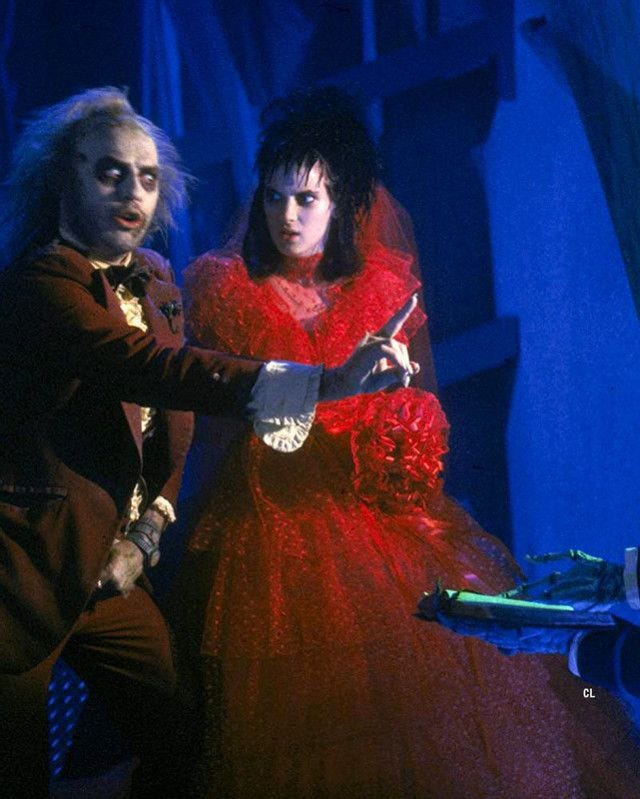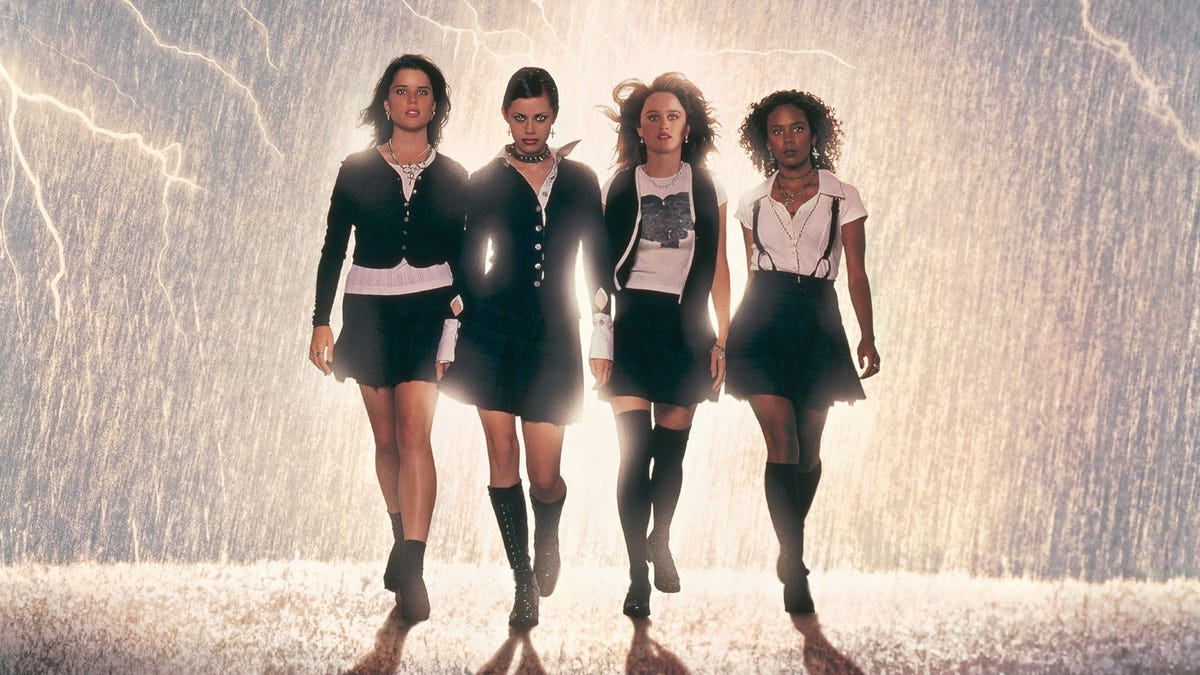The Fashion of the Horror Film
Stop ignoring the outfits, they're actually important to the story.
We all know that fashion is a form of self-expression. When you put on a pair of Louis Vuitton shoes, you’re giving the world a piece of your personality.
Fashion is a statement. You go to a nice restaurant dressed in slacks and a blazer because you want them to understand you respect their establishment. You go to work dressed in “business casual” to show you mean business. You go out to get coffee in jeans because it’s nothing too special—unless it’s a coffee date—in which you then have to dress up juuuuust a little bit.
Even outside of these instances, if you were to go out dressed to the nines just for a shopping trip, chances are that you’re making a statement. You’re saying “I want to look nice” even for something as simple as going to Bath & Body Works.
On the other hand, if you’re dressed in a t-shirt and ripped jeans at a party, you’re saying “I’m laid back.” You’re approachable, you’re cool, people probably want to say hello.
What’s even more interesting about fashion expression is that this same concept of “making a statement” is very obviously seen within the films we watch. Disney villains, for example, are typically dressed in luxurious dark robes and accessories. They’re saying they’re better than you, yet their presence hides something sinister (look at you, Cruella).
Similarly, these same techniques are seen within horror. From the villains to the victims, the fashion they’re seen wearing is incredibly important to how we see their character.
I think one of the most recognizable characters when speaking of this is possibly Freddy Krueger.
No, Freddy is not a fashion icon. However, the clothes he wears are iconic.
Freddy wears a striped sweater and a fedora. While you could argue his razor glove is part of his fashion, I disagree in terms of it being more of an essential weapon rather than an accessory.
The thing is, if you wear a red-and-green sweater with a fedora, you’re probably going to be compared to Freddy Krueger. You don’t need the glove, because the outfit itself is so connected to the character.
But why the hat? Why the sweater? Why didn’t Freddy just wear a jumpsuit or flannel like his fellow slashers?
Well, it was all because Wes Craven.
Craven explained that the hat was based on a man who used to scare him when he was a child. And the sweater? Well, that one is a bit more interesting.
Basically, red and green is difficult for humans to process when they’re together.
As Live Science explains, red light causes retinal cells called opponent neurons to fire—thus alerting our brain that we’re seeing red—while green light doesn’t cause them to do anything (a lack of motion that our brain knows to perceive as green). Since these actions cancel each other out, seeing certain shades of red and green simultaneously can be a little optically confusing. - Ellen Gutoskey
So, yes, Freddy Krueger’s fashion choices are intentional. He wears these colors to confuse his victims, making his hunt easier in the long run.
Perhaps when you think of fashion, your first thoughts go to the legacy brands, fashion houses that have proven themselves for years in the industry. Think Prada, Dior, Chanel, and whatever other stupidly expensive clothing brand you can come up with.
In horror films, we have the likes of American Psycho, Beetlejuice, They Live, and even movies like Heathers and Society that showcase the more prestigious of fashion and lifestyle.
They Live, specifically, uses fashion as a way to separate the aliens and evil elite from the humans and everyday folk. Throughout the film, we see characters like John Nada dressed in casual attire. The 80s jean silhouette, flannels and button downs, working boots and sneakers.
On the other hand, the aliens and the humans who worked under them wore much more elaborate clothing. Wall Street suits and ties, power suits with extravagant earrings. Only the most wealthy and powerful were able to wear the name-brands of something like Gucci.
The only way you were getting your hands on Armani was if you were of another planet or praising the aliens that forced the human race into total materialism.
Of course, this was a film that was made to criticize the decade of greed. It’s no surprise that the wealthy and authoritative figures are dressed in designer, dressed to flaunt their power in the faces of the less fortunate.
We also have Beetlejuice, a visually stunning film on its own, but the fashion the accompanies it only elevates the atmosphere. For starters, we have Delia and Charles Deetz, a couple from New York City that embrace the yuppie lifestyle. They dress in elegant fabrics, but it’s their daughter Lydia who steals the show with her gothic looks.
Lydia uses her fashion as a means of expression, especially in comparison to her father and step-mother. She dresses “strange and unusual,” though still in high quality garments. Her gothic style is her way of saying “I don’t want to be like you,” and Delia sees it clear as day, typically unapproving of her choices.
Obviously, I can’t talk the fashion of Beetlejuice without mentioning Beetlejuice himself. His character, dressed in a dirty suit adorned with black-and-white stripes, shows a zany personality from the jump. But, this suit has become iconic in fashion, especially during the Halloween season.
In other films, we see the fashion staples of the differing decades.
A great example of this comes from Jennifer’s Body, with our main antagonist of the same name dressing in outfits of the 2000s and early-2010s. From her now legendary heart hoodie to the bloodied white prom dress, Jennifer Check’s fashion encapsulates the nostalgia people now have for the decade, with people dressing in Juicy Couture once again.
But her outfits are meant to be more than just something pretty to look at. Jennifer wears the trends so that people in her school know she’s “that bitch.” She’s telling you not to fuck with her through her clothing choices, similar to the Plastiques in Mean Girls or the Heathers in Heathers.
In this instance, it’s Jennifer’s warning to the boys who even dare look at her. She isn’t just another mean girl, she’s a maneater—literally. She wants them to feel threatened and scared, because that’s how she felt when she was ripped of her dignity.
We also have films like The Craft and The Crow, which represent the goth, grunge, and alternative subcultures of the 90s.
The Craft gives us a look into the more feminine side, with characters wearing skirts and leather, leaning heavily into black. They’re wanting to stick out from the rest of 90s mainstream fashion, which was typically much more colorful, full of preppy skirt suits and “cool kid” overalls.
In contrast, the girls of The Craft had lacey tops and combat boots, with Nancy Downs being the frontrunner. So much so that she’s since become a fashion inspiration for many.
With The Crow, we’re exposed to the more masculine side of the subcultures. Eric Draven adorns his famous all-black outfit, rips along his long sleeve with a makeshift corset hugging his torso. Top it off with leather pants and a trenchcoat, and you got an outfit for the ages.
While this is an ode to the goth and grunge fashion of the 90s, it’s also obvious imagery of grievance. The black says he misses his late fiancée, but the roughness of the piece says he’s ready to face the darkness he’s going through.
Similar to how horror films work as a time capsule for their respective decade, so does the fashion that’s featured within them.
I could go on and on about the fashion in different horror films, but that would be a long essay.
I find that fashion is oftentimes an underrated visual for characters, especially in horror. I find that strange, considering how important of a tool it is for people in everyday life. Sure, not everybody is necessarily a fashionista, but there’s no denying the role fashion has in one’s identity.
In horror, we can see this play out with both villains and the victims. Their clothing, a reflection of their personality, is something to always watch out for.
A much more subtle example of this would be Ash Williams of the Evil Dead series. While his attire is rather plain and unassuming, we see it change with his transformation throughout the films. He starts with a very clean look, but by the time we get to The Army of Darkness, it’s completely different.
Ash is much more confident in his abilities and knowledge of the Necronomicon. We get two outfits that reflect this change, though in two different times of his ignorance. In the beginning of the movie, Ash is seen with a ripped open shirt. He’s confident in his survival instincts, and while his shirt is ripped from his night in the cabin, it also shows a much more cocky silhouette of Ash.
In the promotional poster, he’s cheekily seen with his shirt tore open, smirking as a woman clings at his leg. I think that proves my point. But also, I absolutely love that poster. It is so cheesy 90s spicy book material, but in the best way possible.
By the end of the silly antics of the film, Ash’s confidence is derived from his heroism rather than his own selfishness. He dawns armor, chainmail, and even a shiny new hand. He’s literally in the classic interpretation of a knight in shining armor.
So, yeah, fashion and costume design is pretty cool in horror. It definitely doesn’t get as much credit as it deserves. And, listen, I get it: it has some steep competition. I mean, it’s in the running with makeup artist, SFX artists, and fantastical actors. But… I think the fashion deserves some props too.













